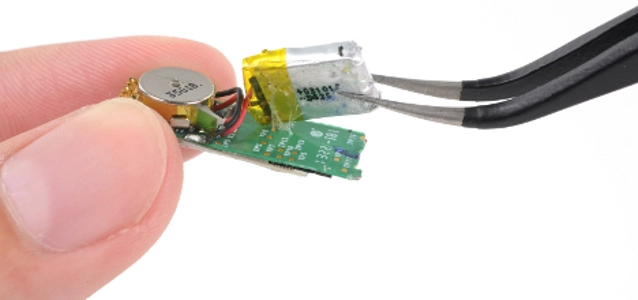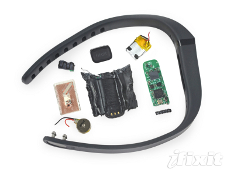
© iFixit
Business |
Fitbit Flex teardown
Here at iFixit, we promote only the healthiest of lifestyles. We eat our vegetables at least once a week, and we never eat pizza two days in a row (unless there are leftovers, of course).
One might go so far as to call us health freaks, and we would not argue. But we are iFixit, and we're ready to sacrifice our fitness ambitions for science. That's why we ripped into Fitbit's newest pedometer/heart rate monitor/sleep tracker wristband to answer an all-important question: What kind of a diet helped this thing fit into its tiny jacket?
Don’t expect to repair your Flex anytime soon... or anytime at all. The device was designed for action, not repair. It's well-nigh impossible to open the wristband without destroying it—so once the battery dies, so will the device. Consequently, the Fitbit Flex earned a 2 out of 10 on our repairability scale.
Teardown highlights: With less effort than peeling an orange, we peel the Fitbit Flex tracker out of the flexible wrist strap. Although it seems like a small consideration, we appreciate how easy it is to separate the electronics from the wrist strap—the component most likely to wear out. Normally we would compare the size of the device to other similar devices. Unfortunately, we don't really have much to compare the Flex to. So how about a half dollar instead? With no visible point of entry, we figure the path to victory can be carved with the judicious application of a sharp cutting tool, also known as a rotary tool. Our first extraction: the light guides for the LEDs that pass for a display on this slim, dare we say emaciated, unit. Next out is the Bluetooth antenna, used for communicating with devices and the accompanying dongle. The device is super fragile once the case is cut open. A tiny hitchhiker came along for the ride when we removed the Bluetooth antenna... a piece of the motherboard. Stuck right on to the front of the board we find a near field communications (NFC) antenna. The NFC tag enables a tap launch of the Flex tracker's associated mobile app with "select NFC-enabled Android devices." The motherboard flexes to show us what it's repping:
- STMicroelectronics 32L151C6 Ultra Low Power ARM Cortex M3 Microcontroller
- Nordic Semiconductor nRF8001 Bluetooth Low Energy Connectivity IC
- Texas Instruments CC2540F128 2.4 GHz Bluetooth Low Energy SoC
- Bluetooth Low Energy Antenna
- USB connection contacts




